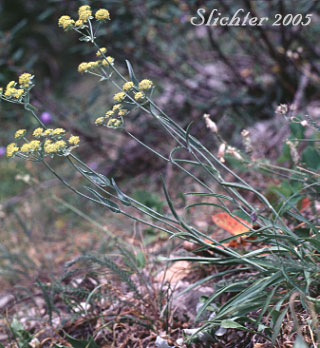
 The
photo at right shows the glaucous, lanceolate to lance-ovate leaves of American
through-wax on Arsenic Mt. on the eastern edge of the Bob Marshall Wilderness
.......August 3, 2000.
The
photo at right shows the glaucous, lanceolate to lance-ovate leaves of American
through-wax on Arsenic Mt. on the eastern edge of the Bob Marshall Wilderness
.......August 3, 2000.
American thorough-wax is a perennial wildflower with several erect to spreading stems arising 5-50 cm high from a persistent, woody base atop a taproot. Plants are glabrous and noticeably glaucous as seen in the photos on this page. The narrow leaves are lanceolate to lance-ovate in shape narrowing gradually to the petiolate base and with several faint veins. The blades are up to 16 cm long and 1 cm wide and the margins are entire. The leaves are more numerous near the base but are also found well up the stems, although they become reduced in size up the stem.
The inflorescence is an umbel of 4-14 rays which are up to 4 cm long at maturity. The umbel is subtended by an involucre of 2-6 leafy bracts from 5-15 mm long and several mm wide. The smaller umbellets at the tip of each ray are compact and subtended by several leafy bractlets from 3-5 mm long. The bracts of both the involucre as well as under the umbellets tend to be irregular in size, with some much larger than the others. The flowers are yellow or occasionally purplish. The fruits are oblong, 3-4 mm long and glaucous with prominent, raised ribs.
The thorough-waxes were once used in China in combination with other herbs to relieve the side effects of steroids.
American thorough-wax may be found on rocky outcrops in forest openings or in open grasslands or dry meadows from the foot of the mountains to above timberline.
American thorough-wax may be found from Alaska east to the Yukon and Northwest Territories and south along the eastern base of the Rocky Mountains to northern and west central Wyoming. It is found westward to Lemhi and Fremont Counties in Idaho and the Wallowa Mts. in northeastern Oregon.